- Omicron spread continues to dent investor sentiment
- Failure of the US Build Back Better Act adds to market concerns
- Goldman reduces forecast for US growth after the bill's collapse
Key Events
The start of a strict coronavirus lockdown in the Netherlands on Sunday as well as the collapse of a $2 trillion US bill that was a cornerstone of the Biden administration's agenda, saw futures on the Dow Jones, S&P 500, NASDAQ and Russell 2000, as well as European shares slump on Monday. Traders are worried that additional health restrictions are likely as the Omicron variant spreads.
Oil plummeted while US Treasuries jumped, forcing yields lower.
Global Financial Affairs
After months of talks between President Joseph Biden and Democratic Senator, Joe Manchin, the Build Back Better Act collapsed when Manchin unexpectedly backed out of supporting the $2 trillion program to expand the social safety net and fund climate change projects.
As a result, Wall Street investment bank behemoth, Goldman Sachs reduced its US GDP growth forecast to 2% for the first quarter, down from 3%; to 3% for Q2 from 3.5%; and to 2.25% from 3% for Q3.
All US futures opened lower as trading began on Monday and extended their slide to over 1%. However, the Russell 2000, whose listed domestic firms are most dependent upon an open economy—as well as Biden's spending plans—suffered the sharpest drop, down more than 1.5%, as of the time of writing.
S&P 500 contracts fell for the second day, increasing the risk of a top.

Dow futures may have peaked below the Nov. 8 high, raising the possibility of a peak-and-trough reversal if the contract falls below the Dec. 1 low.
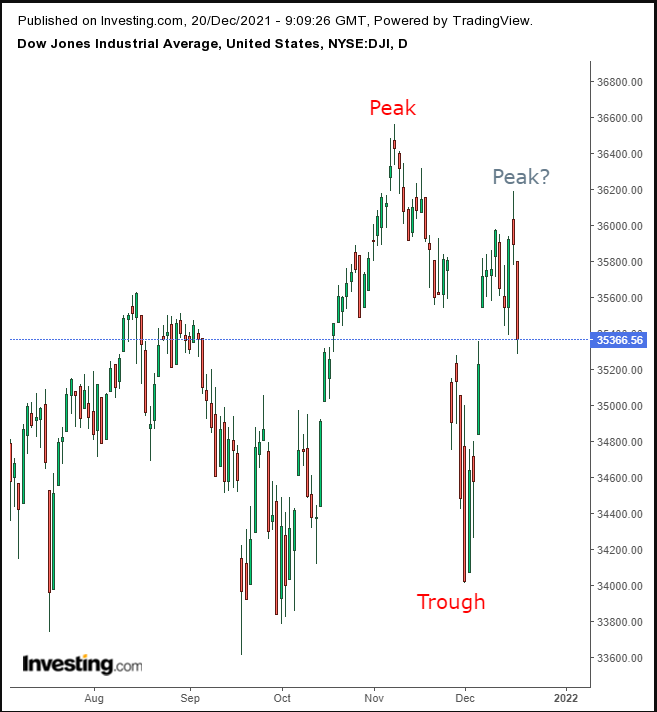
Contracts on the NASDAQ 100 may have confirmed a small H&S top, one in which bulls manage to retest the right shoulder, well above the neckline, which failed to stop the bullish charge. The contract dropped to its lowest level since Oct. 25, testing the uptrend line since the infamous March 2020 bottom.
Futures on the Russell 2000 plunged to the lowest since Jan. 29, as the contract erases nearly a year's worth of progress in a swift drop since the Nov. 8 peak.
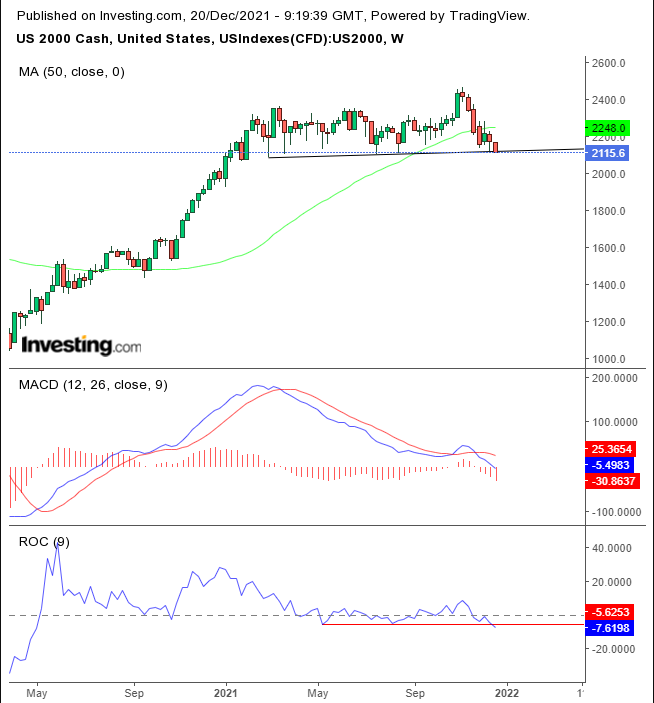
The contracts fell for the sixth out of seven weeks, testing the neckline of a potential top after having cut through the 50 WMA for the first time since scaling above it in August 2020. Both the MACD and the ROC provided bearish signals.
In Europe, the STOXX 600 Index gapped down, opening a full 2% lower, falling to the lowest levels in two weeks. The travel and leisure sector and the energy sector both underperformed, falling about 3%. Both are sensitive to the business cycle.
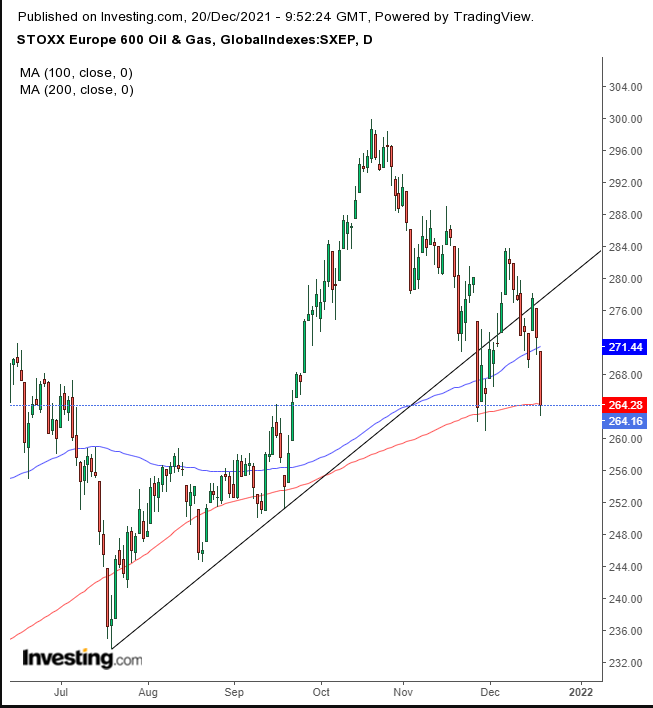
The STOXX Europe 600 Oil & Gas sector index fell below its 200 DMA for the first time since September, as the price reached the lowest level during the same period.
The pan-European benchmark crashed through an array of technical mileposts, including the 100 and 200 DMA, after already having slipped below the October peak and falling beneath the uptrend line since July 20. The gauge is now attempting to remain above the 200 DMA.
Investors seem to be coming to terms with the fact that Omicron is not as benign as they originally thought and are concerned that other countries will follow the Netherlands ahead of the Christmas and New Year holidays, both of which are a crucial time for retail spending.
Earlier this morning Asia was also completely in the red, with Japan's Nikkei suffering a 2.1% drop, even after China announced a cut in its one-year loan prime rate from 3.85% to 3.8%. The PBoC move also failed to prevent a 1.1% selloff in the Shanghai Composite. The rate cut was in line with expectations.
The yield on the 10-year Treasury note fell again, slipping below the neckline of a top after attempting to blow out of it.
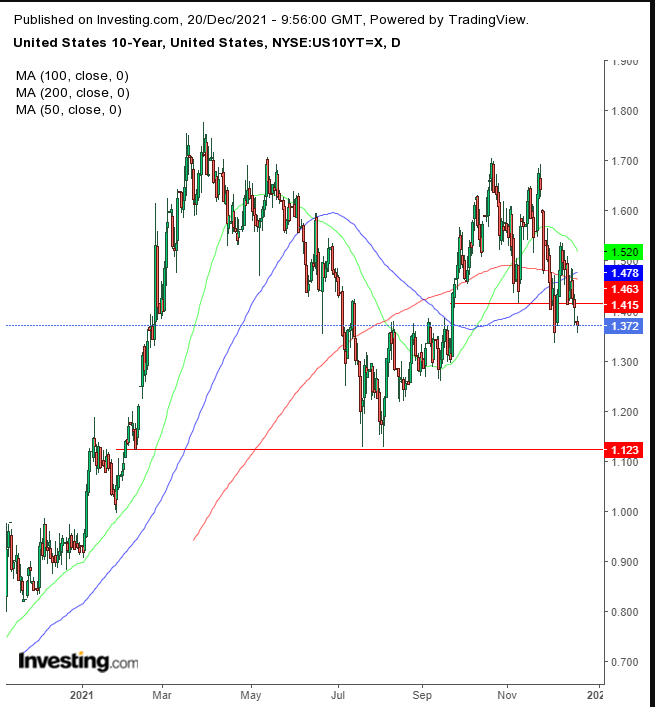
The 50 DMA turned sharply lower, targeting a falling 200 DMA, making such a cross the most bearish. If the top actualizes its implied objective, it will test the neckline of a much larger double top since February.
The dollar edged higher, extending a rally for the second day, testing the Nov. 24 peak.
Gold slipped, ending its two-day rally.
Bitcoin extended a decline below the 200 DMA.
Oil opened 2.3% lower, extending the drop to as much as 6% before recovering somewhat, on fears that renewed coronavirus lockdowns will hit demand.
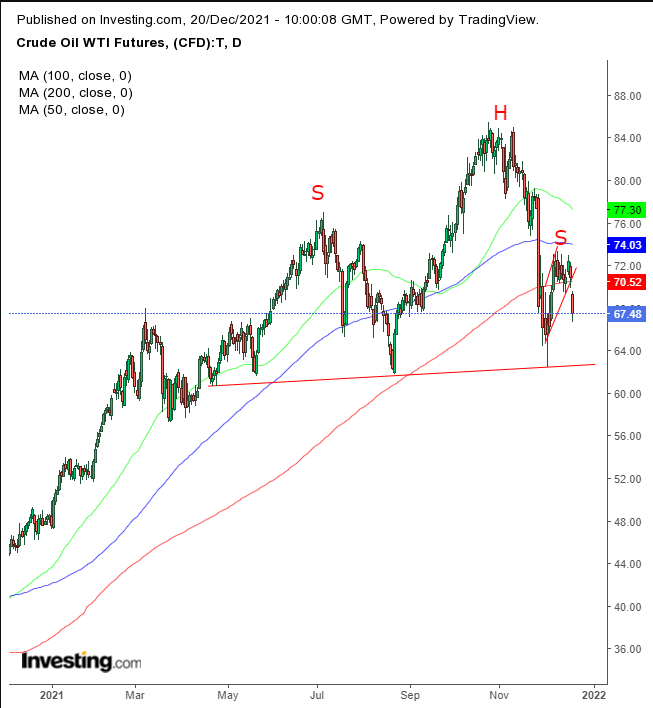
The price of WTI decisively completed a rising flag and received additional oomph after cutting through the 200 DMA to help it complete the H&S top.
Up Ahead
- UK retail sales figures are published on Tuesday.
- On Wednesday, the EIA crude oil inventory report is released.
- The University of Michigan consumer sentiment data is announced on Thursday
Market Moves
Stocks
- The STOXX 600 fell 2.2%
- Futures on the S&P 500 fell 1.4%
- Futures on the NASDAQ 100 fell 1.4%
- Futures on the Dow Jones Industrial Average fell 1.3%
- The MSCI Asia Pacific Index fell 0.9%
- The MSCI Emerging Markets Index fell 0.6%
Currencies
- The Dollar Index was little changed
- The euro rose 0.2% to $1.1258
- The Japanese yen fell 0.1% to 113.58 per dollar
- The offshore yuan was little changed at 6.3883 per dollar
- The British pound fell 0.3% to $1.3208
Bonds
- The yield on 10-year Treasuries declined three basis points to 1.37%
- Germany's 10-year yield fell one basis point to -0.39%
- Britain's 10-year yield fell two basis points to 0.74%
Commodities
- WTI crude fell 4.1% to $67.94 a barrel
- Brent crude fell 2.9% to $71.41 a barrel
- Spot gold was little changed
